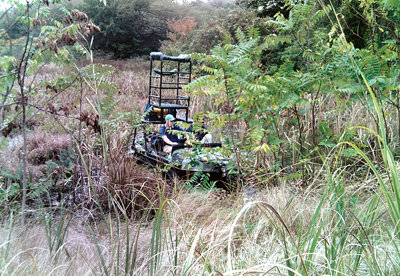
READY TO MOUNT THE FIGHT: Aquatic Control Technology Inc. of Sutton, Mass., prepares to spray the herbicide AquaPro to phragmites that have invaded the wetlands of Buckeye Brook between West Shore Road and Tidewater Drive.

READY TO MOUNT THE FIGHT: Aquatic Control Technology Inc. of Sutton, Mass., prepares to spray the herbicide AquaPro to phragmites that have invaded the wetlands of Buckeye Brook between West Shore Road and Tidewater Drive.
The Buckeye Brook Coalition, a state designated Watershed Council, has begun the first stage of the restoration of a brackish marsh along the eastern side of West Shore Road.
“We felt we needed to take on a bigger role in the protection of the brook,” said Paul Earnshaw, president of the coalition.
The area has been overtaken by invasive vegetation, known as phragmites, a tall reed with a bushy head. Phragmites are a nuisance aquatic plant that was brought to America by early colonial settlers on their ships. Over time the plant has spread, eventually overtaking much of the brook’s wetlands.
“It used to be a beautiful overlook; you could see almost all the way to Tide Water Drive. I noticed over the past 40 years that the view was disappearing,” said Earnshaw.
The growth of the vegetation in certain areas can cause ecological and visibility problems. The self-sustaining brook is a spawning ground for the blue back herring and alewives. Earnshaw worried that the phragmites were going to start choking off the water flow to the brook.
“I wanted to mow it down and bring in salt water because they spread through their roots,” said Earnshaw.
Earnshaw noticed the smell of raw sewage when he was paddling the brook and wondered if that had any relation to the continued growth of the phragmite.
“These plants typically grow with a runoff of storm water, but where this is it was not likely,” said Earnshaw.
In an effort to better understand why the plant was growing and flourishing, the coalition conducted an isotope analysis to find the phragmites food source. Marci Cole Ekberg, a coastal ecologist at Save The Bay, took samples from 20 different sites in the brook.
“It came back one hundred percent positive that the phragmites were growing because of a failing septic system,” said Earnshaw.
After making this discovery, the Rhode Island Rivers Council awarded a $5,000 grant to the coalition to help clean and restore this ecological area in 2008. Luckily, all seven of the homes that were part of the pollution problem tied into the sewer line.
“Since all seven houses tied into the sewer line, no more damage was being done. Eventually the nutrient would have been gone, but once it got a foothold, it is hard to get rid of,” said Earnshaw.
The coalition only needed an additional $1,400 for the plan to get fully funded. That remaining $1,400 was recently financed by a grant from the Coastal Resources Management Council (CRMC). Once the funding was secured, the coalition obtained necessary permits and licensing through CRMC and the Department of Environmental Management (DEM).
One way to fight back against this invasive plant is to apply AquaPro. This herbicide is approved by the Environmental Protection Agency (EPA) and is applied by a licensed company, Aquatic Control Technology Inc. of Sutton, Mass.
“The plants are going to sleep right now for the winter so they are taking in as much nutrients as they possibly can. Applying the herbicide is critical because the plant thinks it is nutrients,” said Earnshaw.
While the plants unknowingly suck in this poison, it is stored in their roots and will spend the winter invading the plants system and eventually killing it. The herbicide is sprayed on with a gun that looks like a power washer. Less than an acre of the reeds was sprayed Friday.
The next phase comes in the late winter, early spring, low ground pressure equipment, and hedge trimmers will mow down the pretreated invasive vegetation. Mulching of the vegetation will further accelerate the deterioration of its growth.
The plants need direct sunlight to grow, so covering them with their own dead remains provides a layer of blockage from the sun.
“Having ten to twelve inches of mulch [sitting on top of the plant’s roots] is difficult to see sunlight,” said Earnshaw.
After they are mowed, another spraying of herbicide will take place throughout the season.
“This will go on for three years with the same procedure,” said Earnshaw.
In an effort to cut costs, when the mowing needs to be done in years two and three, Earnshaw believes he can assemble enough volunteers to come out and hand mow. By killing off phragmites, the natural vegetation will begin to grow back.
“The restoration benefits are to promote the return of native vegetation that will result in reduced soil erosion, degradation of water quality and increasing wildlife habitat. By removing this stand of phragmites, we will be restoring a scenic overlook that has not been seen in over 30 years,” said Earnshaw.